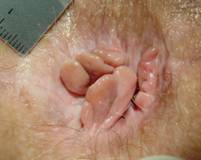A rectal lump is one of the common symptoms in the anorectal diseases in Minnesota. A rectal lump is a growth in the anal canal or rectal area. Rectal lumps vary in size and the degree to which they produce symptoms. Depending on the underlying cause, a rectal lump may or may not cause any pain.
Should you be worried about that bump you just discovered back there? A palpable mass in the anal area may or may not indicate cancer or hemorrhoids. Lumps can be caused by a variety of conditions including anal warts, hemorrhoids, polyps, fissures, or cancer.
- Hemorrhoids are probably the most common reason for having a rectal lump in Minnesota. It can be caused by internal hemorrhoids, but more commonly by external hemorrhoids. If a rectal lump is related to internal hemorrhoids, it usually gets bigger and more prolapsed right after the bowel movement; it could be spontaneously reduced in the early stage of internal hemorrhoids. But it could be non-reducible in the late stage of hemorrhoids. It may be associated with other symptoms such as bleeding, itch or pain. The thrombosed external hemorrhoids are usually very painful if the varicose veins rupture and the blood clots develop.
- Anal warts are caused by human papilloma virus (HPV). HPV infection is considered to be sexually transmitted diseases. Left untreated, anal warts can spread and increase the risk of cancer in the rectal and anal region.
- Anal Fissure is a small cut or split in the anal lining often caused by a painful, hard bowel movement. Fissures are typically located anterior or posterior to the anus. Anal fissure is often associated with a lump called sentinel pile, accompanied by pain and bleeding.
- Rectal Cancer. The rectum is the last six inches of the body’s digestive system, exiting through the anus. One cause of a rectal lump is rectal cancer. Symptoms that require doctor’s attention include blood in the stool, change in bowel habits, tired feeling, abdominal discomfort, change in appetite, or unexplained weight loss.
- Anal cancer occurs in the anal canal, it is account for 2% of cancer in the gastrointestinal tract. An external or internal mass may be palpable. Anal or rectal cancer generally do not produce any pain; Some lesions are so soft that they are missed on palpation. Anal cancer can take several forms including ulcers, polyps or verrucous growths.
- Anorectal abscesses are the result of infection of anal glands in the lining of the anal canal near the opening of the anus. The patient usually has the painful swollen lump if it is superficial abscess. The presence of an abscess warrants surgical incision and drainage as soon as possible. Just antibiotics would be ineffective at this stage in the infection.
If you feel a lump in the anal or rectal area, contact our hemorrhoid clinics in Edina to determine the cause and get treatment. You should seek immediate medical care if the associated symptoms are serious such as high fever, drainage of pus from a rectal lump, severe pain, or bloody stool.
 Anal skin tags often occur if an individual heals the thrombosed external hemorrhoids at home without surgery, the thrombosed hemorrhoids may leave behind skin tags. Anal sentinel tags may also form because of non-hemorrhoid causes, such as anal fissure, surgery, or infection, etc.
Anal skin tags often occur if an individual heals the thrombosed external hemorrhoids at home without surgery, the thrombosed hemorrhoids may leave behind skin tags. Anal sentinel tags may also form because of non-hemorrhoid causes, such as anal fissure, surgery, or infection, etc. 



